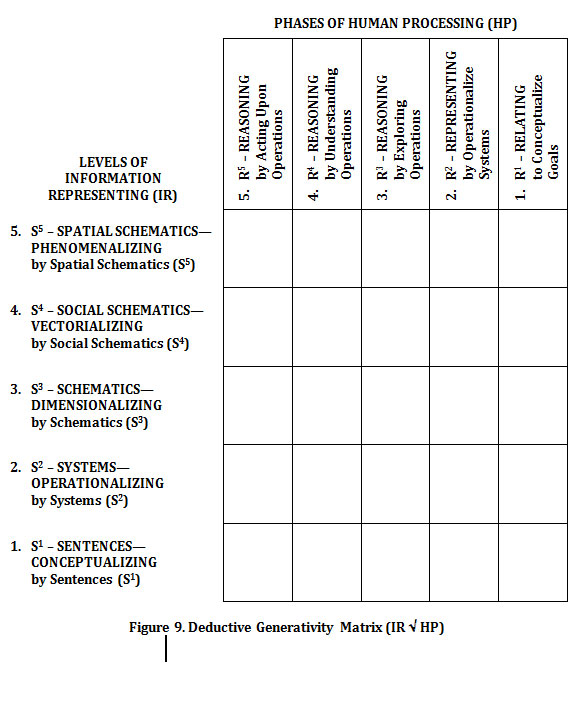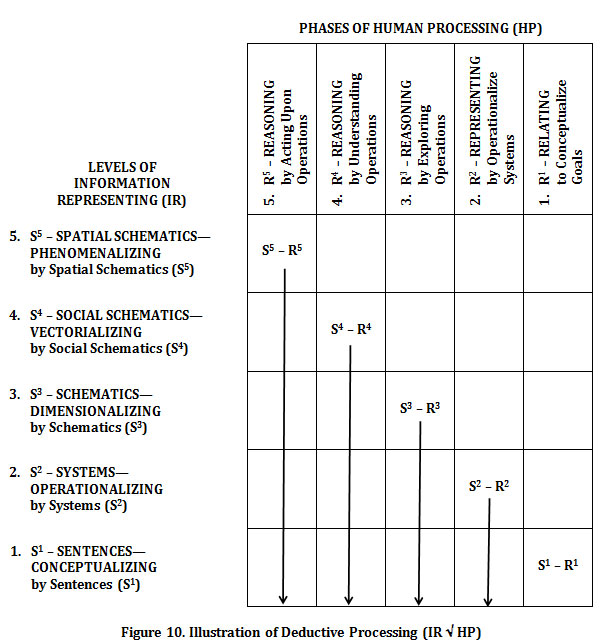Deductive
Just as the inductive generativity processes were aligned at level 1 in their initiation, so are the deductive generativity processes aligned at their highest levels (see Figure 9):
- IR SYSTEMS:
- – S5 – Spatial Schematics
- – S4 – Social Schematics
- – S3 –Schematics
- – S2 – Systems
- – S1 – Sentences
- HP SYSTEMS:
- – R5 – Reasoning by Acting
- – R4 – Reasoning by Understanding
- – R3 –Reasoning by Exploring
- – R2 – Representing by Operationalizing
- – R1 – Relating by Goaling
Again, both IR and HP systems scales are aligned at level 5 in their initiating
Phase 1:
Reasoning to Act Upon Operations
In this first phase of deductive processing, the human processors initiate to act upon operations. They have already reasoned deductively. In this context, the processors will drive the entire generating process by some prior knowledge which they have discovered. In other words, the processors are processing deductively by direction from existing knowledge rather than processing inductively in search of knowledge and direction (see again the S5 level of the IR Scale in Figure 2).
DEDUCTIVE CASE STUDY (S5 – R5)
|
We may illustrate from a case in consulting in the learning area where knowledge exists (see Figure 10). In this case, the educational consultant initiates by defining the relevant operations in educational achievement: |
|
|
Consultant: |
“The most powerful source of educational achievement is the interaction between schools and home backgrounds and family processes. This interaction accounts for more than one-half of educational achievement. |
|
Educator 1: |
“So the interaction between family values and expectancies with home background, including socioeconomic conditions and racial and ethnic group membership, is important.” |
|
Consultant: |
“But only when family processes and home backgrounds interact with school variables do they become critical!” |
|
Educator 2: |
“This means that the homes and neighborhoods and family processes must seek out the schools.” |
|
Consultant: |
“More likely, it means that the schools must aggressively seek to reach out the homes, neighborhoods, and families. Without this interaction, the school accounts for only five percent of educational achievement.” |
|
Educator 1: |
“So the school contributes very little as an independent contributor.” |
|
Educator 2: |
“Only interdependency facilitates the school’s full contribution to learner educational achievement.” |
Again, the assumption of deductive processing is that the helpers have some idea of truth such as the data base on sources of educational achievement.
Phase 2:
Reasoning to Understand Operations
The second phase of deductive processing flows directly from the first phase where the human processors initiate to act upon operations (see again Figure 10). In the second phase, the human processors are driven by prior knowledge which was discovered and shared earlier (S4 – R4). In other words, the processors are processing deductively to understand the social schematics (see again the S4 level of the IR Scale in Figure 2).
DEDUCTIVE CASE STUDY (S4 – R4)
|
In the second phase of deductive processing, then, the human processors follow the direction of the interdependent sources of educational achievement: |
|
|
Educator 2: |
“So we now have our description of interdependency of interactions among the most powerful sources of educational achievement.” |
|
Educator 3: |
“We now need to know how to drill down to penetrate these sources and their relationships.” |
|
Consultant: |
“Well, there are other relationships that contribute uniquely to our interdependency of sources:
|
|
Educator 3: |
“So within our interdependent interactions, there are unique synergistic relationships, like how family values relate to home socioeconomics.” |
|
Educator 1: |
“Or how school curriculum aspirations relate to family aspirations or socioeconomic ‘dissatisfiers.’” |
|
Educator 2: |
“In other words, there are specific interactions that are ‘housed’ or ‘nested’ within the overall interdependent interaction.” |
Phase 3:
Deductive Reasoning to Explore Operations
The third phase of deductive processing probes more deeply into the individual sources of educational achievement (see again Figure 9). In this phase, the human processors are dedicated to exploring the dimensions of individual sources of educational achievement (S3 – R3). In other words, the processors are processing deductively to explore the dimensions of the schematic model (see again the S3 level of the IR Scale in Figure 2).
DEDUCTIVE CASE STUDY (S3 – R3)
|
In the third phase of deductive processing, the human processors follow the direction of the interactive sources of interdependency: |
|
|
Educator 3: |
“I would like to learn how school aspirations relate to home background and family processes.” |
|
Consultant: |
“For a simple example, let us look at three sources: school expectancies relate to family, work expectancies, and middle class home backgrounds.” |
|
Educator 3: |
“In other words, schools relate best to students who expect the most.” |
|
Educator 1: |
“And vice versa!” |
|
Consultant: |
“Let’s take an in-depth view of individual family values which are powerful contributors to matching school values. |
|
Educator 2: |
“The basic function of the family processes is to develop productivity values; e.g., ‘you earn what you learn.’” |
|
Educator 1: |
“The basic components in accomplishing this are the parents.” |
|
Educator 3: |
“And the basic processes in empowering the children are the modeling, didactic, and experiential source of learning. |
|
Consultant: |
“So we can take any one source of effect and analyze its dimensions—functions, components, processes. |
Phase 4:
Deductive Reasoning to Represent Operations
The fourth phase of deductive processing follows through on the operations needed to achieve the functions desired (see again Figure 10). In this phase, the human processors seek to define the operations of the empowering programs (S2 – R2). In other words, the processors are processing deductively to represent the operations of the systems involved (see again the S2 level of the IR Scale in Figure 2).
DEDUCTIVE CASE STUDY (S2 – R2)
|
In the fourth phase of deductive processing, the human processors pursue the achievement of the learning objectives defined by the established educational functions: |
|||||
|
Consultant: |
“For example, what are some of the educational systems that have empowered you in writing skills?” |
||||
|
Educator 1: |
“5W2H. I have found 5W2H to be most helpful to me in learning English grammar:
|
||||
|
Educator 2: |
“I have been empowered to structure my sentences:
|
||||
|
Educator 3: |
“5W2H has really helped me to understand grammar by ‘Diagramming:’” |
||||
|
|
NOUNS ADJECTIVES |
VERBS ADVERBS |
OBJECTS PREPOSITIONS |
|
|
|
Consultant: |
“So we really can break down the systems that empower us to achieve our functions.” |
||||
Phase 5:
Deductive Reasoning to Relate Operations
The fifth phase of deductive processing culminates the operations needed to achieve the desired functions (see again Figure 10). In this phase, the human processors seek to conceptualize the operations verbally in sentences, paragraphs, and reports (S1 – R1). In other words, the processors are processing deductively to communicate the operations involved (see again the S1 level of the IR Scale in Figure 2).
DEDUCTIVE CASE STUDY (S1 – R1)
|
In the last phase of deductive processing, the human processors are attempting to put their operational learning objectives into human communication: |
|
|
Consultant: |
“So what is this deductive processing all about?” |
|
Educator 3: |
“It’s all about educational achievement!” |
|
Educator 2: |
“Growing by knowing!” |
|
Educator 1: |
“Skilling instead of killing!” |
|
Consultant: |
“So it’s all about human benefits.” |
|
Educator 2: |
“It’s all about growing up.” |
|
Educator 3: |
“Instead of going down!” |
By transforming their operational objectives into human communications, the human processors are also articulating their hopes and dreams for the learner benefits of the next generation.
By defining deductive processing operationally, we are complementing our more common inductive processing by building upon accumulated knowledge for the betterment of humankind.


